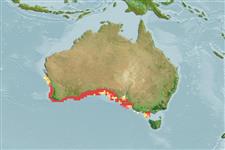Environment: milieu / climate zone / depth range / distribution range
Écologie
marin démersal; océanodrome (Ref. 51243); profondeur 1 - 60 m (Ref. 9563). Temperate; 28°S - 40°S, 112°E - 145°E (Ref. 6205)
Eastern Indian Ocean: Endemic to southern regions of the Australian continental shelf. Distribution ranges from Kangaroo Island in South Australia (Ref. 27573) to Geraldton in Western Australia (Ref. 6335). Report from Western Victoria (Ref. 6205) is erroneous (Ref. 6390). Not yet recorded from western Tasmania.
Length at first maturity / Taille / Poids / Âge
Maturity: Lm 20.0 range ? - ? cm
Max length : 33.0 cm SL mâle / non sexé; (Ref. 6205)
Épines dorsales (Total) : 11 - 13; Rayons mous dorsaux (Total) : 18 - 19; Épines anales: 2; Rayons mous anaux: 18 - 20; Vertèbres: 33 - 35. No dark spot at the base of the pectoral fin; a series of oblique broken rusty brown bars on the back and upper sides, without a longitudinal row of rusty brown blotches along the midlateral silver stripe.
Live close to the sea bed over sandy substrates. Occur in the surf zone of beaches and quiet waters of bays and sandbanks. Are trawled in offshore waters to at least 55 m and possibly deeper. Juveniles may be found in shallow water off white sand beaches, together with accumulations of dead seaweed in the surf zone during spring and summer in Western Australia. Move into shallow waters in large schools during full moon (Ref. 6205). Feed mainly on crustaceans, amphipods, decapods, mysids and copepods. Juveniles consume mostly copepods (Ref. 6223). Oviparous (Ref. 205), and are multiple spawners with asynchronous development (Ref. 12343).
S. bassensis is a multiple spawner and spawns asynchronously during the breeding season (Ref. 12343).
McKay, R.J., 1992. FAO Species Catalogue. Vol. 14. Sillaginid fishes of the world (family Sillaginidae). An annotated and illustrated catalogue of the sillago, smelt or Indo-Pacific whiting species known to date. Rome: FAO. FAO Fish. Synop. 125(14):87p. (Ref. 6205)
Statut dans la liste rouge de l'IUCN (Ref. 130435: Version 2024-2)
Menace pour l'homme
Harmless
Utilisations par l'homme
Pêcheries: intérêt commercial mineur; pêche sportive: oui
Outils
Articles particuliers
Télécharger en XML
Sources Internet
Estimates based on models
Preferred temperature (Ref.
123201): 15.2 - 20.5, mean 17.8 °C (based on 100 cells).
Phylogenetic diversity index (Ref.
82804): PD
50 = 0.5000 [Uniqueness, from 0.5 = low to 2.0 = high].
Bayesian length-weight: a=0.00832 (0.00351 - 0.01970), b=3.07 (2.86 - 3.28), in cm total length, based on LWR estimates for this (Sub)family-body shape (Ref.
93245).
Niveau trophique (Ref.
69278): 3.3 ±0.47 se; based on food items.
Generation time: 4.2 ( na - na) years. Estimated as median ln(3)/K based on 2
growth studies.
Résilience (Ref.
120179): Milieu, temps minimum de doublement de population : 1,4 à 4,4 années (K=0.26-0.29).
Fishing Vulnerability (Ref.
59153): Moderate vulnerability (37 of 100).
